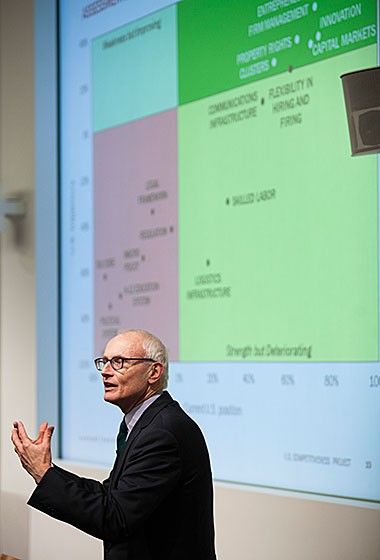Stronger Could Compromise Competitiveness US News
Post on: 21 Май, 2015 No Comment

The greenback reached a four-year high this week, raising concerns over lower inflation for the Fed.
The U.S. economy posted strong gains in the second quarter after a slow start to the year, newly revised data from the Commerce Department showed Friday, but already economists are starting to worry about a new looming headache: The U.S. dollar.
A strong greenback is good news for anyone who owns dollar-backed assets like corporate bonds and Treasury notes. The U.S. dollar has appreciated markedly in recent months — since the beginning of July, the dollar is up 5 percent against the currencies of major trading partners – and this week the DXY index, which measures the dollar against a handful of other currencies, reached its highest level in four years.
But a stronger dollar could be a drag on U.S. competitiveness abroad — making American exports more costly and less attractive overseas while making relatively cheaper imports more desirable back home — and could compromise overall growth. The trend would be disinflationary and could weigh on Fed monetary policy changes.
“It undermines our ability to sell abroad, it undermines our ability to compete against imports as well. These are all things that are really important as we’re moving forward,” says Diane Swonk, chief economist at Mesirow Financial.
Further dollar appreciation would dampen inflation, which already runs below the Federal Open Market Committee’s 2 percent goal, by putting downward rather than upward pressure on the price of goods. The Fed has a two-pronged policy objective: Stabilizing prices through that level of inflation and reaching full employment. Continued low inflation could delay the Fed’s decision to raise short-term interest rates, which have held near zero since the end of 2008 to encourage cheap lending and more spending after the financial crisis.
The FOMC said at its latest policy meeting it will maintain the current level of low interest rates “ for a considerable time ” after ending its large-scale bond buying program known as quantitative easing, which is slated to wrap up in October. Fed Chair Janet Yellen has said rate decisions aren’t calendar-sensitive and rather depend on improvements in overall economic conditions.
“What we want is to have self-sustaining demand. The Fed wants the economic party to be so loud that even as the noise gets ramped up and interest rates rise a little bit, they can sneak out the back door without anyone knowing that they’ve left,” Swonk says.
A higher dollar’s potential to slow inflation is one concern New York Federal Reserve President William Dudley voiced this week at the Bloomberg Markets Most Influential Summit in New York. The dollar’s movement is one of many factors in the Fed’s economic forecast that in turn influences monetary policy, he said.
“Obviously as the dollar moves, it affects the appropriateness of a given monetary policy to achieve those [dual] objectives,” he said.
The “legs on the dollar” won’t be felt on overall growth for another three or four quarters, Swonk says. That coincides roughly with the mid-2015 date when many economists believe the Fed will start raising short-term interest rates.
The dollar’s recent appreciation, if maintained, would lower gross domestic product growth by about 0.15 percentage points in 2015 and 0.1 percentage points in 2016, according to a report this week from Goldman Sachs researchers. And if the appreciation accelerates, the impact on growth could become “more significant,” at 0.25 percentage points in 2015 and 0.3 percentage points in 2016.
A report Friday from the Commerce Department showed that the world’s largest economy expanded at an annual rate of 4.6 percent in the second quarter, up from a contraction of 2.1 percent in the first. This was the third and final estimate of GDP growth for the second quarter and was higher than the second estimate of 4.2 percent growth. Exports, notably travel services, helped boost the upward revision.
Manufacturing, in particular car and truck production, is one industry that’s shown recent strengthening, such as the improvement in durable goods orders excluding the volatile aircraft category. But it could feel the pangs of a stronger dollar relative to other currencies. The yen, for example, is approaching its weakest level in six years against the dollar, giving Japan a big cost advantage on its car sales in the U.S.
“It’s interesting because back in the early ’80s when we had a very strong dollar and people were talking about the U.S. being a safe haven … the idea was that it was welcomed,” Swonk says. “I grew up in the Detroit area, and it was not welcomed at all. It was decimating along with higher oil prices.”
Economists at the Cleveland Fed seem less concerned about the inflation risks of a stronger dollar. In a post Thursday, researchers William Bednar and Edward Knotek II acknowledge a link between an appreciated dollar and lower import prices, but said it won’t have a major negative impact on inflation.














